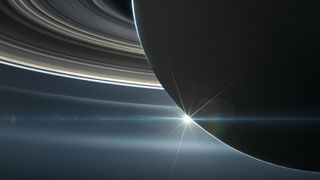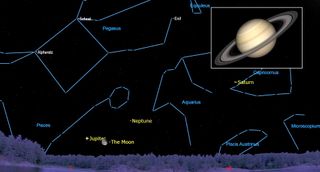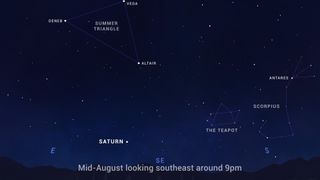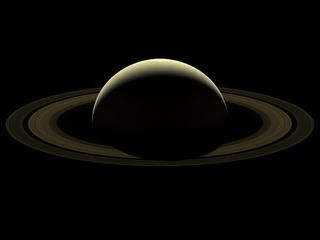
It's time to watch the "Lord of the Rings" once again.
If you step outside on Thursday (Aug. 11) and look toward the east-southeast horizon shortly after 9 p.m. local time, you'll see the August full moon slowly ascending the sky. And as you watch, take note also of a bright yellow-white "star" shining to the moon's upper left.
Except that's not a star, but quite possibly the most spectacular planet in our solar system: The ringed wonder, Saturn.
Related: Saturn's Rings: Composition, Characteristics & Creation

By around after midnight, you'll see that Saturn will have shifted to a position almost directly above the moon as the two appear one-third up from the south-southeast horizon to the point directly overhead (the zenith). Normally this would also be the night when most stargazers would be intent on watching for Perseid meteors, but unfortunately this year that same bright moon will act like a celestial spotlight, lighting up the sky and squelching the light of all but the very brightest meteor streaks.
So, perhaps as a consolation prize, we should turn our attention to Saturn, sometimes dubbed the "telescopic showpiece of the night sky."
Interestingly, however, that out of the five brightest planets, Saturn seems to be the least alluring to the naked eye. Mercury, for example, is the speediest planet, shifting rapidly back-and-forth from one side of the sun to the other. Venus is by far and away the brightest of the five, glowing brilliantly, sort of like a celestial night light, either in the east at dawn or in the west at dusk. Mars is the most colorful, shining a fiery yellow-orange, while Jupiter, though not as brilliant as Venus, can appear to dominate the sky all through the night.
Get the Space.com Newsletter
Breaking space news, the latest updates on rocket launches, skywatching events and more!

Slow and sheepish
And Saturn? Visually there is nothing really distinctive about it to make it stand out. If for nothing else, its most revealing characteristic was that it was by far the slowest of the known planets. The age-old astronomers of thousands of years ago regarded Saturn as the "highest" planet, occupying the outermost or highest sphere before that of the fixed stars.
In ancient days, before we had knowledge of the more distant planets Uranus, and Neptune, Saturn was presumed to be the farthest and slowest-moving known planet and hence reminded ancient skywatchers of the Greek god Cronus, the god of time. But he's more usually recognized as the Roman god of agriculture.
The name is related to both the noun satus (seed corn) and the verb serere (to sow).
But why would the planet Saturn be linked to agriculture? Perhaps a clue can be found from the Assyrians who referred to Saturn as lubadsagush, which translated, meant "oldest of the old sheep." Possibly this name was applied because Saturn seems to move so very slowly among the stars; it may have also reminded skywatchers of the slow gait of plowing oxen or cattle.
Indeed, since Saturn requires 29.5 years to orbit the Sun, its progress through the zodiacal constellations is quite slow, averaging 2.5 years per constellation. Currently we find it within the eastern portion of the somewhat dim star pattern of Capricornus the Sea Goat. The last time this planet occupied this part of the sky was early in 1993.

A telescope makes a big difference
Yes, viewed with only your naked eye, Saturn appears only as a bright golden star shining with a steady glow; nothing that really calls your attention to it. But the ring system that makes it both beautiful and spectacular cannot be seen. To show the rings you will need either high-powered binoculars (mounted on a sturdy tripod) or a small telescope magnifying at least 25-power. Of course, larger telescopes employing higher magnifications will make the view increasingly impressive; the larger the aperture and the sharper the image, the more detail you can make out.
Even in small telescopes, they surprise observers with their chilling beauty and icy, glimmering elegance, in spite of the fact that it is expected. If you have a 2.4-inch telescope, your best view of Saturn will come at 60-power. With a 3-inch telescope, try 75-power; with a 6-inch, 150-power is a good choice.
When I'm showing off Saturn in my 10.1-inch Dobsonian reflector, I usually use a magnification of 250-power. The best reactions come from those who have never seen it through a telescope. What usually follows are exclamations of astonishment and delight:
"No way!"
"Oh my god!"
"That's awesome!"
And on more than one occasion, I have been accused of showing a slide of Saturn upon gazing through the eyepiece of my telescope. "Nope," I tell the disbelieving viewer, "What you're looking at is the real thing."
While they look solid, the rings actually consist of billions of particles — largely water ice — that range in size from microscopic specks to flying mountains miles across. Each particle revolves around Saturn in its own orbit; likely they are icy fragments of a satellite that probably ventured too close to Saturn and was torn apart by tidal forces.
The rings are currently tilted 14 degrees toward Earth and still show up quite well. Unfortunately, in the years to come, they will eventually close to a point where by the spring of 2025 they will turn edgewise toward the sun and Earth and become all but impossible to see.

Looking for a telescope to see Saturn? We recommend the Celestron Astro Fi 102 as the top pick in our best beginner's telescope guide.
See it now!
Now is the best time to observe Saturn. On Sunday night (Aug. 14), Saturn arrives at opposition, when it lies on the opposite side of the sky from the sun. This is also when its apparent size is greatest, and so it stages an all-night performance with greatest gleam. It now is rising as the sun sets, reaches its highest point in the southern sky around 1 a.m. (local daylight time) and sets when the sun rises. When at opposition, Saturn is also at its closest point in its orbit relative to the Earth for this year: 823 million miles (1.32 billion km) away. It currently shines at a respectfully bright magnitude of +0.3; that's just a trifle brighter than the similarly colored winter star Procyon, which ranks eighth among the 21 brightest stars in the sky.
But even after its midsummer opposition, Saturn will still be in fine position to be seen right on through the end of this year. By the second week of October, it will be peaking due south at around 9 p.m. local daylight time. And even around Christmas you'll still be able to find it at nightfall low in the southwest sky until it sets around to 8:30 p.m.
Final factoids
In addition to the rings, Saturn, at last count, has 82 moons. Of these, fifty-three are confirmed and named, while the other 29 are still awaiting confirmation of discovery and official naming. Saturn's moons range widely in size. The largest is Titan, 3,200 miles (5,150 km) in diameter and the second largest natural satellite in the solar system; larger even than the planet Mercury. It is also the only known moon with a significant atmosphere, consisting primarily of organonitrogen compounds. As for the smallest moons of Saturn, they likely are no larger than a few hundred feet across.
The theoretical construction of Saturn — 74,900 miles (120,500 km) wide — resembles that of Jupiter; it is either all gas, or has a small dense center surrounded by a layer of liquid and a deep atmosphere. And since its specific gravity is less than that of water, Saturn would float — if you could only find an ocean large enough to drop it in!
Joe Rao serves as an instructor and guest lecturer at New York's Hayden Planetarium. He writes about astronomy for Natural History magazine, the Farmers' Almanac and other publications. Follow us on Twitter @Spacedotcom and on Facebook.
Join our Space Forums to keep talking space on the latest missions, night sky and more! And if you have a news tip, correction or comment, let us know at: community@space.com.

Joe Rao is Space.com's skywatching columnist, as well as a veteran meteorologist and eclipse chaser who also serves as an instructor and guest lecturer at New York's Hayden Planetarium. He writes about astronomy for Natural History magazine, the Farmers' Almanac and other publications. Joe is an 8-time Emmy-nominated meteorologist who served the Putnam Valley region of New York for over 21 years. You can find him on Twitter and YouTube tracking lunar and solar eclipses, meteor showers and more. To find out Joe's latest project, visit him on Twitter.
